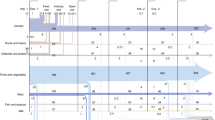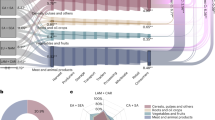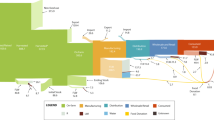Abstract
Accurate global food losses and waste (FLW) quantification remains challenging owing to limited harmonized global estimates, a lack of comprehensive quantification approaches and an absence of frameworks for addressing FLW challenges. Here we compile a country-level database that assesses FLW across global value chains and quantifies the nutritional and environmental impact of FLW for 121 countries and 20 composite regions. Between 2004 and 2014, FLW increased by a quarter, especially in sub-Saharan Africa and Southeast Asia, where increasing nutritional losses of ~550 cal per capita per day impact food security. Growing food imports in high-income countries and fast-growing economies worsened FLW and related environmental footprints in exporting low-income regions. Reducing overconsumption and FLW in high-income countries may have positive effects in middle- and low-income countries, where food exports largely drive farm-level losses. Policies should focus on promoting the profitable reuse of unavoidable FLW while enhancing agricultural production efficiency to improve water use and nutritional security.
This is a preview of subscription content, access via your institution
Access options
Access Nature and 54 other Nature Portfolio journals
Get Nature+, our best-value online-access subscription
$29.99 / 30 days
cancel any time
Subscribe to this journal
Receive 12 digital issues and online access to articles
$119.00 per year
only $9.92 per issue
Buy this article
- Purchase on Springer Link
- Instant access to full article PDF
Prices may be subject to local taxes which are calculated during checkout





Similar content being viewed by others
Data availability
The FLW database and results data are available in Supplementary Information.
Code availability
The code used for the analysis is described in Supplementary Information.
References
UN Responsible consumption and production. United Nations Sustainable Development Goals https://www.un.org/sustainabledevelopment/sustainable-consumption-production/ (2019).
Porter, S. D., Reay, D. S., Higgins, P. & Bomberg, E. A half-century of production-phase greenhouse gas emissions from food loss & waste in the global food supply chain. Sci. Total Environ. 571, 721–729 (2016).
Lipinski, B. et al. Reducing Food Loss and Waste (World Resource Institute, 2013); https://www.wri.org/publication/reducing-food-loss-and-waste
Parry A., James K. & LeRoux S. Strategies to Achieve Economic and Environmental Gains by Reducing Food Waste (Waste & Resources Action Programme, 2015); https://newclimateeconomy.report/workingpapers/wp-content/uploads/sites/5/2016/04/WRAP-NCE_Economic-environmental-gains-food-waste.pdf
Foley, J. A. et al. Solutions for a cultivated planet. Nature 478, 337–342 (2011).
UNEP Food Waste Index Report 2021 (United Nations Environment Programme, 2021); https://www.unep.org/resources/report/unep-food-waste-index-report-2021
Global Food Losses and Food Waste—Extent, Causes and Prevention (FAO, 2011).
Sheahan, M. & Barrett, C. B. Review: Food loss and waste in sub-Saharan Africa. Food Policy 70, 1–12 (2017).
Xue, L. et al. Missing food, missing data? A critical review of global food losses and food waste data. Environ. Sci. Technol. 51, 6618–6633 (2017).
Food Loss and Waste Database (FAO, accessed 3 January 2023); http://www.fao.org/platform-food-loss-waste/flw-data/en/
‘Waste: Food Waste’, OECD Environment Statistics (OECD, accessed 3 January 2023); https://doi.org/10.1787/ba9da2b7-en
Kaza, S., Yao, L. C., Bhada-Tata, P. & Van Woerden, F. What a Waste 2.0: A Global Snapshot of Solid Waste Management to 2050 (World Bank, 2018); https://openknowledge.worldbank.org/entities/publication/d3f9d45e-115f-559b-b14f-28552410e90a
Kummu, M. et al. Lost food, wasted resources: global food supply chain losses and their impacts on freshwater, cropland, and fertiliser use. Sci. Total Environ. 438, 477–489 (2012).
Parfitt, J., Barthel, M. & Macnaughton, S. Food waste within food supply chains: quantification and potential for change to 2050. Philos. Trans. R. Soc. Lond. B 365, 3065–3081 (2010).
Delgado, L., Schuster, M. & Torero, M. Quantity and quality food losses across the value chain: a comparative analysis. Food Policy https://doi.org/10.1016/j.foodpol.2020.101958 (2021).
Caldeira, C., De Laurentiis, V., Corrado, S., van Holsteijn, F. & Sala, S. Quantification of food waste per product group along the food supply chain in the European Union: a mass flow analysis. Resour. Conserv. Recycl. 149, 479–488 (2019).
Liu, J., Lundqvist, J., Weinberg, J. & Gustafsson, J. Food losses and waste in China and their implication for water and land. Environ. Sci. Technol. 47, 10137–10144 (2013).
Chaboud, G. & Daviron, B. Food losses and waste: navigating the inconsistencies. Glob. Food Secur. 12, 1–7 (2017).
Britz, W. et al. Economy-Wide Analysis of Food Waste Reductions and Related Costs JRC Working Paper No. JRC113395 (Joint Research Centre, 2019); https://econpapers.repec.org/paper/iptiptwpa/jrc113395.htm
de Gorter, H., Drabik, D., Just, D. R., Reynolds, C. & Sethi, G. Analyzing the economics of food loss and waste reductions in a food supply chain. Food Policy https://doi.org/10.1016/j.foodpol.2020.101953 (2020).
Alexander, P. et al. Losses, inefficiencies and waste in the global food system. Agric. Syst. 153, 190–200 (2017).
Chen, C., Chaudhary, A. & Mathys, A. Nutritional and environmental losses embedded in global food waste. Resour. Conserv. Recycl. 160, 104912 (2020).
Wesana, J., Gellynck, X., Dora, M. K., Pearce, D. & De Steur, H. Measuring food and nutritional losses through value stream mapping along the dairy value chain in Uganda. Resour. Conserv. Recycl. 150, 104416 (2019).
Chepeliev, M. Incorporating nutritional accounts to the GTAP data base. J. Glob. Econ. Anal. 7, 1–43 (2022).
Population, total (World Bank, 3 January 2023);https://data.worldbank.org/indicator/SP.POP.TOTL
Ang, B. W. LMDI decomposition approach: a guide for implementation. Energy Policy 86, 233–238 (2015).
Kaya, Y. & Yokoburi, K. Environment, Energy, and Economy: Strategies for Sustainability (United Nations Univ. Press, 1997).
Parfitt, J., Croker, T. & Brockhaus, A. Global food loss and waste in primary production: a reassessment of its scale and significance. Sustainability https://doi.org/10.3390/su132112087 (2021).
Verma, M., de Vreede, L., Achterbosch, T. & Rutten, M. M. Consumers discard a lot more food than widely believed: estimates of global food waste using an energy gap approach and affluence elasticity of food waste. PLoS ONE 15, e0228369 (2020).
Reducing Food Loss and Waste—Setting a Global Action Agenda 34–35 (WRI, 2019); https://files.wri.org/s3fs-public/reducing-food-loss-waste-global-action-agenda_1.pdf
FAO Regional Office for Latin America and the Caribbean. International day of awareness of the reduction of food losses and waste. (2022); https://www.fao.org/americas/events/event-detail/International-Day-of-Awareness-of-the-Reduction-of-Food-Losses-and-Waste/
Spiker, M. L., Hiza, H. A. B., Siddiqi, S. M. & Neff, R. A. Wasted food, wasted nutrients: nutrient loss from wasted food in the United States and comparison to gaps in dietary intake. J. Acad. Nutr. Diet. 117, 1031–1040.e22 (2017).
Khalid, S. et al. Assessment of nutritional loss with food waste and factors governing this waste at household level in Pakistan. J. Clean. Prod. 206, 1015–1024 (2019).
Brennan, A. & Browne, S. Food waste and nutrition quality in the context of public health: a scoping review. Int. J. Environ. Res. Public Health 18, 5379 (2021).
De Boer, I. J. M. & Van Ittersum, M. K. Circularity in Agricultural Production (Wageningen Univ. & Research, 2018); https://www.wur.nl/upload_mm/7/5/5/14119893-7258-45e6-b4d0-e514a8b6316a_Circularity-in-agricultural-production-20122018.pdf
Gatto, A., Kuiper, M., van Middelaar, C. & van Meijl, H. Unveiling the economic and environmental impact of policies to promote animal feed for a circular food system. Resour. Conserv. Recycl. 200, 107317 (2024).
Toma, L., Revoredo-Giha, C., Costa-Font, M. & Thompson, B. Food waste and food safety linkages along the supply chain. EuroChoices 19, 24–29 (2020).
World Population Prospects 2022: Summary of Results UN DESA/POP/2022/TR/NO. 3 (United Nations Department of Economic and Social Affairs, Population Division, 2022).
Yi, J. et al. Post-farmgate food value chains make up most of consumer food expenditures globally. Nat. Food 2, 417–425 (2021).
Aguiar, A., Chepeliev, M., Corong, E. L., McDougall, R. & van der Mensbrugghe, D. The GTAP data base: version 10. J. Glob Econ. Anal. https://doi.org/10.21642/JGEA.040101AF (2019).
Chepeliev, M. The GTAP Version 10A Data Base with Agricultural Production Targeting Based on the Food and Agricultural Organization (FAO) Data GTAP Research Memorandum No. 35 (Center for Global Trade Analysis, Purdue Univ., 2020); https://www.gtap.agecon.purdue.edu/resources/res_display.asp?RecordID=6180
Fabi, C. & English, A. SDG 12.3.1: Global Food Loss Index (Food and Agriculture Organisation of the United Nations, 2018); http://www.fao.org/3/CA2640EN/ca2640en.pdf
Baldos, U. Development of GTAP 9 Land Use and Land Cover Data Base for Years 2004, 2007 and 2011 GTAP Research Memorandum No. 30 (Global Trade Analysis Project (GTAP), Purdue Univ., 2017); https://www.gtap.agecon.purdue.edu/resources/res_display.asp?RecordID=5424
Haqiqi, I., Taheripour, F., Liu, J. & van der Mensbrugghe, D. Introducing irrigation water into GTAP data base version 9. J. Glob. Econ. Anal. 1, 116–155 (2016).
Chepeliev, M. Development of the Non-CO2 GHG Emissions Database for the GTAP 10A Data Base GTAP Research Memorandum No. 32 (Global Trade Analysis Project (GTAP), 2020); https://www.gtap.agecon.purdue.edu/resources/res_display.asp?RecordID=5993
IPCC Climate Change 2007: Synthesis Report (eds Core Writing Team, Pachauri, R. K. & Reisinger, A.) (IPCC, 2007).
Yang, J. et al. Driving forces of China’s CO2 emissions from energy consumption based on Kaya-LMDI methods. Sci. Total Environ. 711, 134569 (2020).
Peters, G. P. et al. Key indicators to track current progress and future ambition of the Paris Agreement. Nat. Clim. Change https://doi.org/10.1038/nclimate3202 (2017).
Acknowledgements
We have no acknowledgements and received no specific funding for this work.
Author information
Authors and Affiliations
Contributions
A.G. and M.C. conceived and designed the experiments, performed the experiments, analysed the data, contributed materials and analysis tools, and wrote the paper.
Corresponding authors
Ethics declarations
Competing interests
The authors declare no competing interests.
Peer review
Peer review information
Nature Food thanks Tariq Ali and the other, anonymous, reviewer(s) for their contribution to the peer review of this work.
Additional information
Publisher’s note Springer Nature remains neutral with regard to jurisdictional claims in published maps and institutional affiliations.
Supplementary information
Supplementary Information
Supplementary Methods, Figs. 1–8 and Tables 1–18.
Supplementary Data 1
File containing a new global database of FLW and embedded nutritional and environmental impacts.
Rights and permissions
Springer Nature or its licensor (e.g. a society or other partner) holds exclusive rights to this article under a publishing agreement with the author(s) or other rightsholder(s); author self-archiving of the accepted manuscript version of this article is solely governed by the terms of such publishing agreement and applicable law.
About this article
Cite this article
Gatto, A., Chepeliev, M. Global food loss and waste estimates show increasing nutritional and environmental pressures. Nat Food 5, 136–147 (2024). https://doi.org/10.1038/s43016-023-00915-6
Received:
Accepted:
Published:
Issue Date:
DOI: https://doi.org/10.1038/s43016-023-00915-6
This article is cited by
-
Quantitative food loss in the global supply chain
Nature Food (2024)



